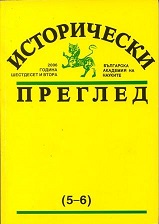Византийската сфрагистика в България(1900-2010)
Byzantine Sigillography in Bulgaria (1900–2010)
Author(s): Ivan JordanovSubject(s): History
Published by: Институт за исторически изследвания - Българска академия на науките
Summary/Abstract: The Byzantine sigillography in Bulgaria has specific development, which can be traced in several directions: The first one is related to the need for the information of the seals. It is highly valued by the Bulgarian mediaevalists and in particular by the patriarch of the Bulgarian mediaeval studies and byzantologist Professor Vasil Zlatarski. The information coming from the seals is still actively used by scholars who deal with Byzantine history, prosopography, administration, rank hierarchy, settlements etc. The second direction is connected with publications of Byzantine seals found on the territory of today’s Bulgaria. The earliest publications are of European dimension: the author of the first publication is the founder of the Byzantine sigillography, Gustave Schlumberger (1844–1929). The next publication is again a result of an international collaboration. It announced the findings of seals and coins, discovered during the first archeological expedition in Aboba Pliska (1899–1900). The author of that publication is the eminent Russian byzantologist and an expert in sigillography, B. Panchenko (1878–1920). Gradually the collection of seals of the National Archeological Museum was formed. Its enrichment and publication is due to a great extend to N. Mushmov (1869–1942). Another collection was set up around mediaeval Drustur. It was initiated by the headmaster of the local lyceum Pericle Papahagi in collaboration with Professor N. Banescu. In general Silistra or mediaeval Drustur was connected with the work of Romanian scholars such as N. Banescu, I. Barnea, P. Deaconu and other modern scientists. It can be stated that until its inauguration in 1978 the seals registered as found on the territory of Bulgaria did not exceed about hundred, and they were kept in different museums and private collections. The turning point came in 1978, when during archeological excavations in Preslav the foundations of a building were discovered and it turned out that the building was used as an archive of the local Byzantine strategos in the period from 971 to 1088. In and around that building more than 500 Byzantine seals were found, as well as more than 250 lead seals and 4 casts. Those findings occasioned the beginning of the project Corpus of Byzantine seals from Bulgaria, which was successfully concluded in 2009 with the publication of three volumes in English.
Journal: Исторически преглед
- Issue Year: 2011
- Issue No: 5-6
- Page Range: 236-254
- Page Count: 19
- Language: Bulgarian
- Content File-PDF

